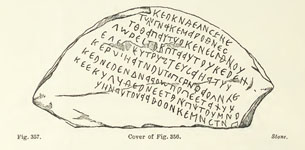Previous First Next
SALAMIS IN THE ISLAND OF CYPRUS.
BY ALEXANDER PALMA DI CESNOLÀ, F.S.A.,
page 133
Cyprus was now sold by Richard to the Templars for 100,000 gold bezants, about £300,000 sterling. The rule of the knights was severe and unpopular, and weary of their bargain, they begged that they might be permitted to restore the island to Richard, and to receive back the 40,000 bezants already paid on account. The latter condition the king would not agree to; but at last, Guy de Lusignan intervened, and, on paying Richard 60,000 bezants, was invested by him with the sovereignty of the island, of which he took possession May 1192. Guy now resigned his claims to the throne of  Jerusalem, and devoted himself to restoring order and tranquillity in the island. But he reigned scarcely two years, and, perhaps, never actually assumed the title of King of Cyprus. He died in April 1194, and was succeeded by his brother Amaury. I may appropriately conclude this chapter upon coins with fig. 356, which represents a broken and imperfect jar found at Salamis, containing a mass of bronze coins encrusted together so thoroughly, that very little could be deciphered upon them. The jar was closed with a fiat stone (fig. 357) of irregular shape, having upon it several lines of Greek capital letters, which I am inclined to believe were inscribed upon it to resemble an exorcism or anathema, in order that ignorant and superstitious finders might be deterred from Jerusalem, and devoted himself to restoring order and tranquillity in the island. But he reigned scarcely two years, and, perhaps, never actually assumed the title of King of Cyprus. He died in April 1194, and was succeeded by his brother Amaury. I may appropriately conclude this chapter upon coins with fig. 356, which represents a broken and imperfect jar found at Salamis, containing a mass of bronze coins encrusted together so thoroughly, that very little could be deciphered upon them. The jar was closed with a fiat stone (fig. 357) of irregular shape, having upon it several lines of Greek capital letters, which I am inclined to believe were inscribed upon it to resemble an exorcism or anathema, in order that ignorant and superstitious finders might be deterred from

robbing the hoard which the owner and depositor hoped at some future time to recover.

END
Previous First Next
|